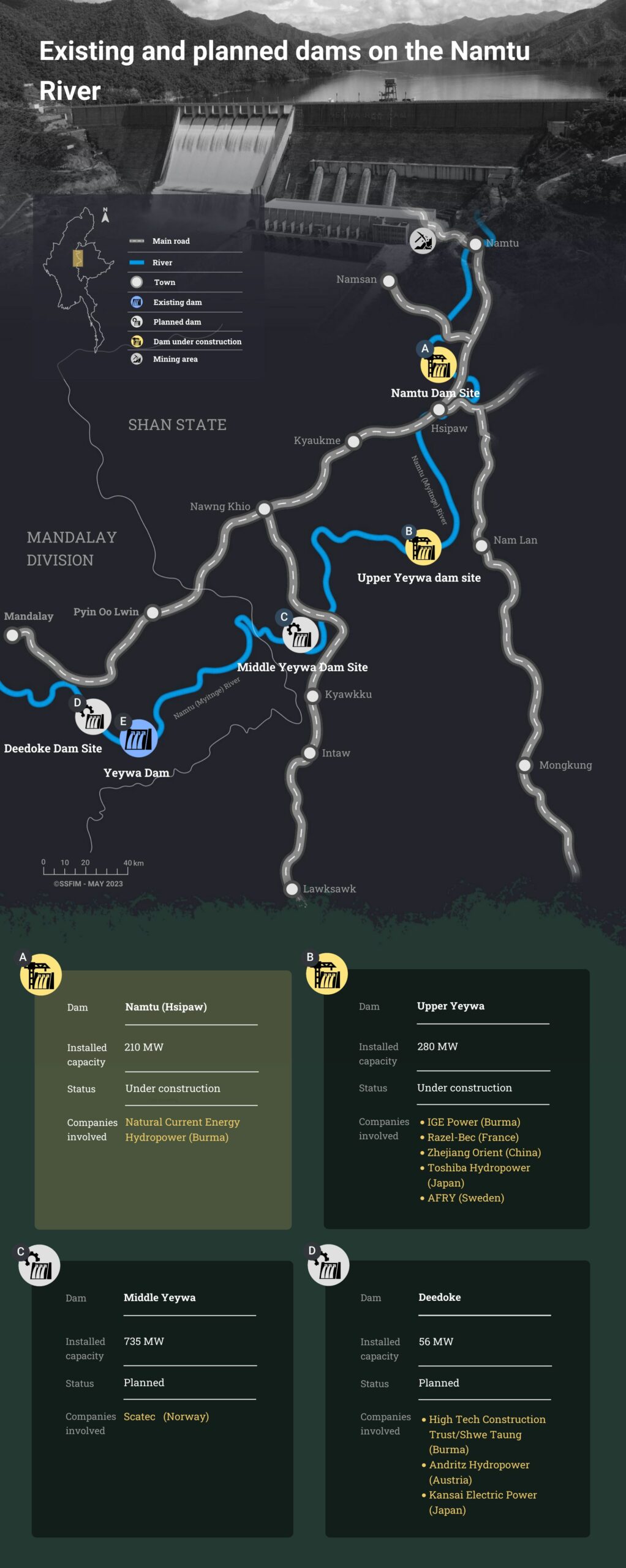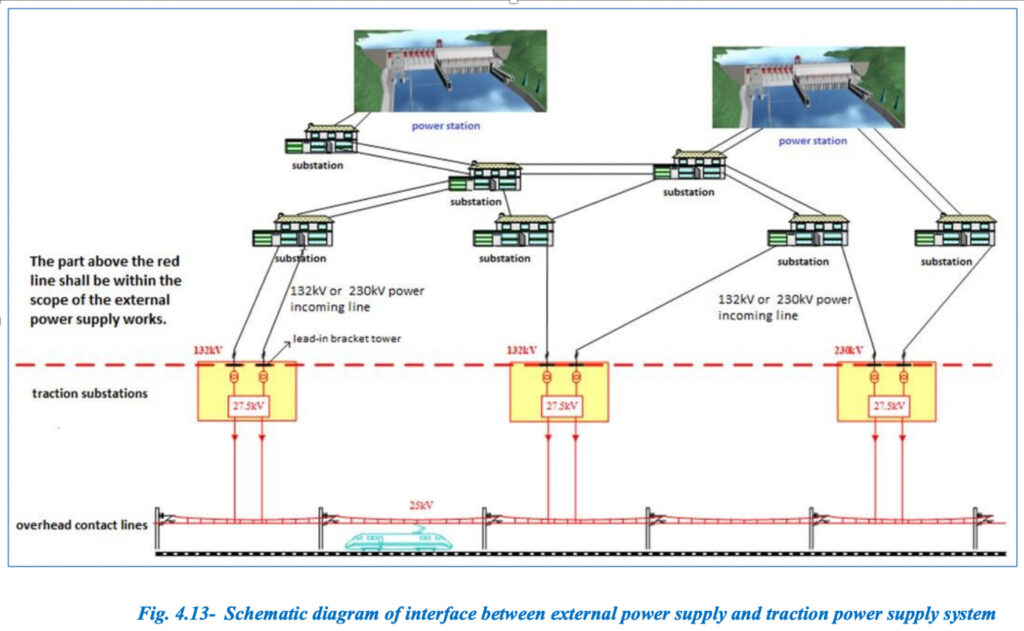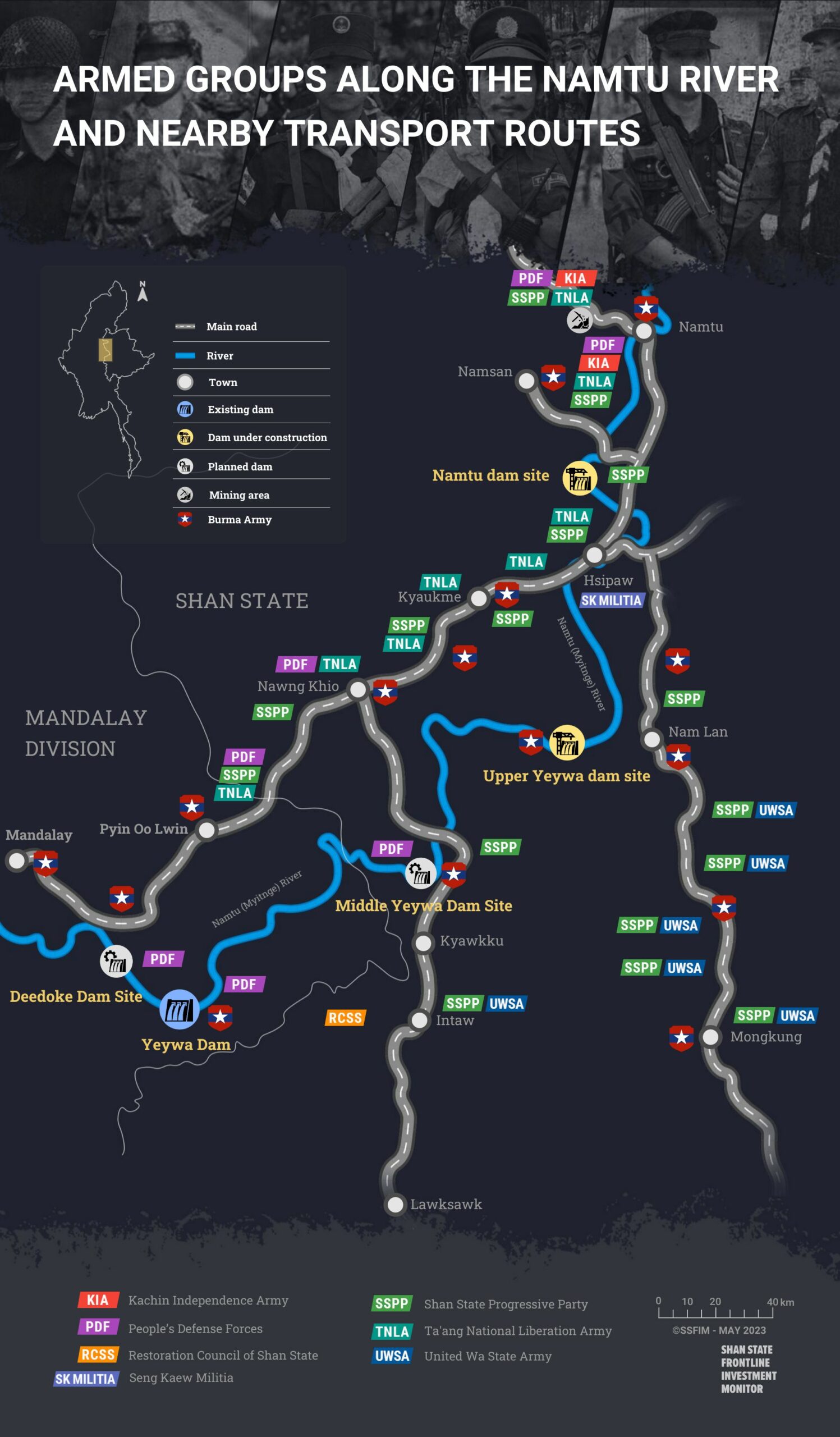
A company owned by the United Wa State Army (UWSA) is proceeding at fast pace with construction of the Namtu dam on the Namtu/Myitnge river, 20 kilometers north of Hsipaw town in northern Shan State, despite community opposition.
A formal agreement to build the 210 megawatt Namtu (Hsipaw) dam was signed in Naypyidaw on April 29, 2022, between the UWSA’s Natural Current Energy Hydropower Company (NCEH) and the SAC regime’s Department of Electric Power and Planning. Since then, locals have noticed a significant increase of activity around the dam site, including large numbers of loaded trucks arriving from the direction of Lashio, and an influx of over a hundred Chinese workers, who speak no Burmese – supporting the widely held assumption this is a China-backed project.
NCEH had started preparatory work for the dam in 2017, long before formal approval of the project and before an environmental impact assessment (EIA) was carried out. This was revealed in a 2020 update by the community coalition, Action for Shan State Rivers, exposing how NCEH had been illegally clearing protected forest, building roads to the dam site, and constructing rows of concrete workers’ housing.
In 2018 and 2019, Nang Kham Aye, the Shan Nationalities’ League for Democracy MP for Namtu township, raised formal complaints about this unauthorized construction in the Naypyidaw parliament, calling for the Namtu dam project to be halted. However, no serious action was taken against NCEH, who continued on-site dam preparation.
NCEH, set up in 2013, describes itself on its website as working for “design, investment and implementation” of hydropower plants, but has no record of involvement in other projects apart from the Namtu dam. The company not only managed to obtain an MOU in 2014 for a Build-Operate-Transfer (BOT) agreement for the Namtu dam, but also a later BOT agreement for a 47-mile-long 230kV overhead transmission line from the Namtu dam to the Upper Yeywa dam in Kyaukme township. There is no public information about the terms of these BOT agreements, nor how NCEH will fund these costly projects – the Namtu dam alone will cost USD 436 million, according to an EIA scoping report by MyAsia Consulting in 2018.
The 210 MW Namtu dam is the third dam to be constructed on the Namtu river, out of a planned cascade of five dams. The 790 MW Yeywa dam on the lower Namtu was completed in 2010, while the 280 MW Upper Yeywa dam, started in 2008, is still not completed.

The Namtu dam plans have been shrouded in secrecy from the outset. The original April 2014 MOU was for a 100 megawatt dam, and this capacity was listed in the International Finance Corporation’s Strategic Environmental Assessment of the Myanmar Hydropower Sector, carried out in 2017-2018. However, by 2018 the planned capacity had already increased to 210 megawatts, according to MyAsia Consulting’s EIA scoping report for the Namtu dam.
The current map of the “Existing Power Grid and Under Construction Projects” on the website of the SAC’s Ministry of Electric Power does not show the planned Namtu dam, nor the planned 230kV transmission line linking to the Upper Yeywa dam.
The proximity of this new transmission line to the route of China’s planned Muse-Mandalay electric railway is fueling speculation that the Namtu dam’s main purpose will be to power the Chinese rail project, rather than serve local people’s electricity needs. The EIA for the railway’s power supply makes it clear that hydropower will be the main source of energy for the rail project — another mega investment facing stiff community resistance.


Diagram from EIA for Muse-Mandalay Railway (Power Supply System) – May, 2021
MyAsia Consulting’s scoping report lists numerous negative impacts of the Namtu dam, which were to be “studied in detail during the EIA study phase”. However, the EIA report for the dam has not been made publicly available.
Upstream dam impacts mentioned by the scoping report include the fact that the reservoir will submerge the Shan village of Lilu and 140 hectares of arable land. Downstream impacts include starvation of sediment for downstream banks, reduction in water flow affecting downstream hydrology, disturbance to aquatic life, and dam safety. The report states: “The dam safety is of serious concern to the people who live in the downstream area. The breach of the dam may result in a catastrophic disaster.”
The over 20,000 residents of Hsipaw town, situated on the Namtu river only 20 kilometers downstream of the Namtu dam, would directly suffer from such a disaster. Parts of the town are already prone to flooding from river overflow after heavy rainfall, meaning that even without dam breakage, sudden large releases of water could cause significant damage, although this is not mentioned in the scoping report.

Another impact omitted from the scoping report is potential pollution of the dam reservoir from upstream mining. In 2020, Action For Shan State Rivers warned: “Given plans to restart large-scale excavation in the Bawdwin-Namtu lead-silver mines, about 40 kilometers upstream of the Namtu dam site, it is also certain that the dam reservoir will become very polluted, impacting the health of villagers downstream. Lead poisoning is particularly dangerous for children, retarding physical and mental development.” With mining resuming at a fast pace at Bawdwin since the coup, this is a very real concern.
The ongoing lack of transparency and disregard of local concerns by the Namtu dam-builders underscore the urgency of demands by Shan community groups for an immediate halt to all dam construction on the Namtu river, and for a dam-building moratorium throughout Burma until devolution of power under a new federal constitution, allowing local communities to protect their own natural resources.
There are numerous armed resistance groups operating along the Namtu river, some with ceasefire agreements and some in active conflict with the SAC regime. Yet, construction of the Namtu and Upper Yeywa dams has been able to continue amidst this highly contested landscape – making it clear that security guarantees have been obtained from the various armed actors.
This raises serious questions about the priorities of the armed resistance groups, and why they are letting dam building continue – and, in the case of UWSA, directly profiting from project construction — when these dams are strongly opposed by local communities, and only serve the interests of the illegitimate SAC regime and hydropower investors.
On April 25, 2023, thirteen Shan civil society groups issued an open letter to ethnic armed resistance groups and political parties in Shan State, warning of the damaging impacts of the Namtu and Upper Yeywa dams, and expressing concern that the regime’s lack of transparency about the projects “will indirectly impact states’ efforts to establish a federal democracy.” They urged the armed groups and political parties to stand with local communities and “use any means” to help stop the construction of dam projects.


